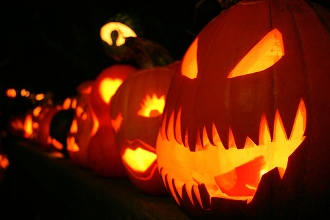Halloween and the Celtic new year: Local Neopagan reverend explains Samhain history, modern rituals

Many Pagan followers celebrate Samhain, an ancient New Year's Festival that includes communicating with spirits of the dead, yet still participate in modern Halloween festivities, such as carving jack-o-lanterns.
Photo courtesy of flickr
Yet for local Neopagans (believers influenced by Paganism), some of the ancient rites long associated with Halloween are still yet to come.
During the weekend of Nov. 6-7, Neopagans of the Druid tradition will travel from across Southeast Michigan to Botsford Recreational Preserve, just outside the city limits of Ann Arbor, for Samhain Weekend. (Samhain is the official name for the end-of-harvest festival and ancient Celtic New Year).
Since hosting its first Samhain Weekend almost 10 years ago, Shining Lakes Grove of Ann Arbor is gearing up to make this year’s event bigger than ever.
“We’ve added some new programs this year; in the afternoon, we’ll have a more modern group, and things will be family-oriented,” says Reverend Robert Henderson, Senior Druid of Shining Lakes Grove. “The evening rite is more traditional, because we communicate with ancestors and honor the dead, and we also worship the Lord of the Dead, Manannan. We get in touch with our ancestors of blood, of spirit - that is, people who have influenced us, such as teachers or writers - and of place, or the people who lived in this space before we did.”
Another tradition long tied with modern Halloween reflects the poverty of ancient Ireland.
“At this time, the ancient Irish had to decide what livestock they could afford to keep alive through the winter, and I think that this has a lot to do with the association of death with this time of year,” says Henderson. “Yes, I think this was very much on the minds of the ancient Irish.”
The ancients held no specific date for Samhain, says Henderson, as it changed each year depending on the end of the harvest and the timing of the first frost. Traditions vary for modern Pagans, and the Neopagan Druid tradition followed by Shining Lakes Grove - A Druid Fellowship (ADF) - marks it as halfway between the autumnal equinox and the winter solstice.
“It really depends on who you ask, because October 31 is more of a Christianized date,” explains Henderson. “October 31 is the eve of All Saints’ Day.”
While the Pagan Samhain is accompanied by millennia-old rituals, modern rites are performed at this time, too.
“Locally, we elect our officers, and Friday night is the swear-in and beginning of the new term,” says Henderson. “Our business reporting also has to be turned in the ADF.”
As for October 31, the local Druids will be spending the evening just like their neighbors.
‘I’ll be doing the trick-or-treating with family, and watching ‘The Nightmare Before Chrismas’ when we’re done” says Henderson. “We know that our members want to celebrate Halloween with their families. I really think of Samhain and Halloween as two different holidays.”
Stephanie Fenton covers faith for AnnArbor.com.
Stephanie can be reached at Fenton.Stephanie@gmail.com.

Comments
Rob Henderson
Sat, Oct 31, 2009 : 12:27 p.m.
Thanks for writing this article about us! I did want to make one correction: Our Samhain this year is on the 6th and 7th of November, not the 5th and 6th.